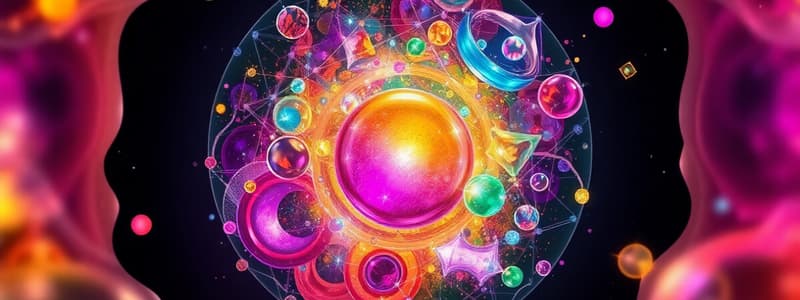Podcast
Questions and Answers
What distinguishes a compound from an element?
What distinguishes a compound from an element?
- A compound is represented on the periodic table.
- A compound consists of one type of atom.
- A compound cannot be broken down into simpler substances.
- A compound is formed by the chemical combination of two or more elements. (correct)
Which of the following is a characteristic of mixtures?
Which of the following is a characteristic of mixtures?
- Mixtures are combined chemically in fixed ratios.
- Mixtures can be homogeneous or heterogeneous. (correct)
- Mixtures consist of only one type of substance.
- Mixtures cannot retain the physical properties of their components.
Which of the following best describes a solution?
Which of the following best describes a solution?
- A solution has a non-uniform composition.
- A solution must contain multiple solvents.
- A solution is always cloudy and not clear.
- A solution is a homogeneous mixture where one substance is dissolved in another. (correct)
Which separation method would be most appropriate for separating a solid from a liquid?
Which separation method would be most appropriate for separating a solid from a liquid?
What property of a pure substance does not change with the amount of substance present?
What property of a pure substance does not change with the amount of substance present?
What is the primary application of pure substances in the medical field?
What is the primary application of pure substances in the medical field?
Which of the following methods employs centrifugal force for separation?
Which of the following methods employs centrifugal force for separation?
What is a common example of a heterogeneous mixture?
What is a common example of a heterogeneous mixture?
Flashcards are hidden until you start studying
Study Notes
Matter Purity Study Notes
Elements vs. Compounds
-
Elements:
- Pure substances that cannot be broken down into simpler substances.
- Consist of one type of atom (e.g., hydrogen, oxygen).
- Represented on the periodic table.
-
Compounds:
- Pure substances formed by the chemical combination of two or more elements.
- Have a fixed ratio of components (e.g., water H2O, carbon dioxide CO2).
- Can be broken down into their constituent elements through chemical reactions.
Mixtures and Solutions
-
Mixtures:
- Combinations of two or more substances where each retains its properties.
- Classified into:
- Homogeneous: Uniform composition (e.g., air, saltwater).
- Heterogeneous: Distinct, separate components (e.g., salad, sand and iron filings).
-
Solutions:
- Homogeneous mixtures where one substance (solute) is dissolved in another (solvent).
- Characteristics include clarity, uniformity, and stability.
- Examples: sugar in water, vinegar.
Properties of Pure Substances
-
Physical Properties:
- Distinct characteristics (melting point, boiling point, density).
- Remain constant regardless of the amount of substance.
-
Chemical Properties:
- Behaviors that occur during chemical reactions (reactivity, flammability).
- Dependent on the substance's chemical structure.
Methods of Separation
-
Filtration:
- Separates solids from liquids or gases using a barrier (filter paper, membrane).
-
Distillation:
- Separates components based on differences in boiling points.
-
Chromatography:
- Separates mixtures based on how different substances move through a medium.
-
Evaporation:
- Removes a solvent from a solution, leaving behind solute.
-
Centrifugation:
- Uses centrifugal force to separate components based on density.
Applications of Pure Substances
-
In Industry:
- Used in the production of pharmaceuticals, chemicals, and materials.
-
In Research:
- Essential for chemical analysis, drug formulation, and scientific experiments.
-
In Daily Life:
- Purified water for drinking, essential oils in aromatherapy, and food additives.
-
In Medicine:
- Pure substances are crucial in diagnostics and therapeutic formulations.
Elements vs. Compounds
- Elements are the simplest forms of matter, unable to be broken down further, consisting of a single type of atom.
- Examples of elements include hydrogen and oxygen, which are listed on the periodic table.
- Compounds are created from the chemical union of two or more elements, characterized by specific ratios of elements.
- Common examples of compounds are water (H2O) and carbon dioxide (CO2), which can be decomposed into their constituent elements through chemical reactions.
Mixtures and Solutions
- Mixtures consist of multiple substances where each retains its own properties, allowing for physical separation.
- Homogeneous mixtures have a uniform composition (e.g., air, saltwater), while heterogeneous mixtures have visibly distinct components (e.g., salad, mixtures of sand and iron filings).
- Solutions are a type of homogeneous mixture where a solute is dissolved in a solvent, leading to characteristics like clarity and stability.
- Common examples of solutions include sugar dissolved in water and vinegar.
Properties of Pure Substances
- Physical properties include attributes such as melting point, boiling point, and density, which remain unchanged regardless of the amount present.
- Chemical properties describe how a substance reacts in chemical processes, including traits like reactivity and flammability, which hinge on the substance's molecular structure.
Methods of Separation
- Filtration utilizes barriers such as filter paper to separate solids from liquids or gases.
- Distillation exploits the differences in boiling points to separate components from a mixture.
- Chromatography separates substances based on their movement through a medium, which can vary among the components of a mixture.
- Evaporation is a method to eliminate a solvent from a solution, producing solid solutes.
- Centrifugation applies centrifugal force to distinguish and separate components based on their density differences.
Applications of Pure Substances
- In the industrial sector, pure substances are critical for manufacturing pharmaceuticals, chemicals, and various materials.
- Within research fields, they are vital for chemical analyses, drug development, and scientific experimentation.
- In daily life, purified water is essential for drinking, while essential oils are used in aromatherapy, and food additives must be pure for safety and efficacy.
- In medicine, pure substances are fundamental for diagnostic procedures and the creation of therapeutic and treatment formulations.
Studying That Suits You
Use AI to generate personalized quizzes and flashcards to suit your learning preferences.




